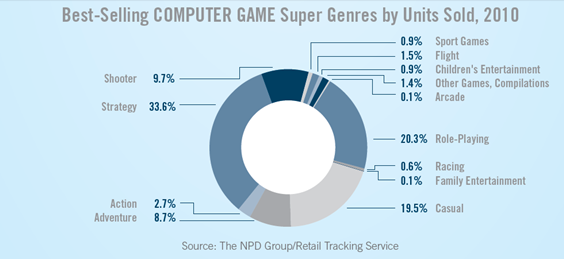

Children in MEDCs, by their living in a wealthier environment, are more likely to have access to computers, television, and gaming systems than children in LEDCs. From 2004 until 2010, the "amount of time the average 8- to 18-year-old spent with media is up by 1 hour, 17 minutes a day -- from 6 hours, 21 minutes in 2004 to 7 hours, 38 minutes" according to Steven Reinberg ‐ a HealthDay Reporter for Bloomberg Business Week. (Reinberg, 2010) The attachments that children and teenagers experience towards media can be used to spread the message of biodiversity.
Currently, websites such as www.biodiversity911.org and National Geographic provide biodiversity games that users can play for free. These games take on the form of question-answer scenarios and simple interactive screens. However, these games rarely make the headlines of the video gaming world while games such as "Final Fantasy", "Legend of Zelda", "Mario", "Civilization", "Halo" and others are among the top ranked games of all time. (The Best Video Games in the History of Humanity 2011) The above video games are all RPGs (Role-Playing-Games) and often include complicated plot lines. It comes as no surprises that the simplistic free biodiversity games available online do not compare in popularity to these action filled stars of the video gaming world.
Currently, the message of biodiversity is most often promoted in written literature and also video-documentaries as opposed to more creative forms of communication such as video games. The idea that video games can be used to support educational endeavors is growing. For example, In New York, the John D. and Catherine T. MacArthur Foundation is supporting efforts to create public school that will use principles of game design like instant feedback and graphic imagery to promote learning. (Motoko 2008)
International Committee on Biodiversity invests in a role-playing computer game that mimics the game-style of popular RPG games but revolves around central ideas of the conservation of biodiversity.
Games such as Citadel, Civlization, Age of Empires, Heroes of Might and Magic and others focus on the idea that the player can build up his/her own city and control its functions. The game created by International Committee on Biodiversity can center on the users building up their own cities and interacting with their environment, ecosystems and biodiversity within in order to establish a society that relies on the natural resources to survive. If the user takes advantage of natural resources, he/she will not be able to sustain his/her city long enough to conquer the lands of opposing players. Since the player will be competing either against computer opponent or online real-time players, he/she will be encouraged to plan the city such that it can co-exist with surrounding ecosystems and draw upon resources without causing biodiversity loss. In order to develop and maintain the city, the player will have to plan for food production and agricultural expansion, collection of resources, mining, development of medicine and making use of surrounding plants, hunting to feed the population, and other features that require the player to interact with the environment in the same way countries do with their lands. This game can be packaged together with a short biodiversity-awareness booklet that will serve as a real-life guide for this video game.
According to By Yo Takatsuki Business reporter for BBC World Service, "back in 1982, the Japanese company Namco produced Pacman for 100,000 USD. Now, the average Playstation 3 title is estimated to cost 15,000,000 USD." (Takatsuki 2007)
In order to execute the development of a popular video game, ICB would need to contract and split the cost of development with one of the game developers/companies such as Sid Meier or BUKA Entertainment or others.
Minimum Cost: 2,000,000 USD
Maximum Cost: 10,000,000 USD
 |
Since this game would fall under the categories Strategy and Role-Playing, it would have the potential to make up for the costs with profit because Strategy and Role Playing games make up over 50 percent of best selling computer games in United States. (Figure 1)